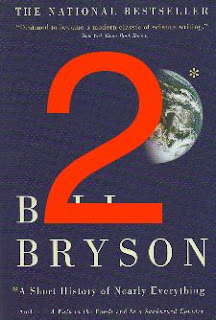 Is a wonderfully well written account of nearly everything! Otherwise, it wouldn't be called "A Short History of Nearly Everything"! As audacious as the title is, it is a really wonderful tour de force of ideas, personalities, coincidences and facts that have shaped the very foundations of scientific inquirey. Thanks to this book, I actually get what E=MC2 means, and I don't consider myself stupid--(what moron ever does!) None-the-less, this is a wonderful read full of ideas, personalities, facts, and possibilitites.
Is a wonderfully well written account of nearly everything! Otherwise, it wouldn't be called "A Short History of Nearly Everything"! As audacious as the title is, it is a really wonderful tour de force of ideas, personalities, coincidences and facts that have shaped the very foundations of scientific inquirey. Thanks to this book, I actually get what E=MC2 means, and I don't consider myself stupid--(what moron ever does!) None-the-less, this is a wonderful read full of ideas, personalities, facts, and possibilitites.Here are a couple of passages to illustrate my assertion.
 "Only half a dozen times in recorded history have supernovae been close enough to be visible to the naked eye. One was a blast in 1054 that created the Crab Nebula. Another, in 1604, made a star bright enough to be seen during the day for over three weeks. The most recent was in 1987, when a supernova flared in a zone of the cosmos known as the Large Magellanic Cloud, but that was only barely visible and only in the southern hemisphere--and it was a comfortably safe 169,000 light-years away.
"Only half a dozen times in recorded history have supernovae been close enough to be visible to the naked eye. One was a blast in 1054 that created the Crab Nebula. Another, in 1604, made a star bright enough to be seen during the day for over three weeks. The most recent was in 1987, when a supernova flared in a zone of the cosmos known as the Large Magellanic Cloud, but that was only barely visible and only in the southern hemisphere--and it was a comfortably safe 169,000 light-years away.Supernovae are significant to us in one other decidedly central way. Without them we wouldn't be here."
 "When the poet Paul Valéry once asked Einstein if he kept a notebook to record his ideas, Einstein looked at him with a mild but genuine surprise. "Oh, that's not necessary, " he replied. "It's so seldom that I have one." I need hardly point out that when he did get one it tended to be good."
"When the poet Paul Valéry once asked Einstein if he kept a notebook to record his ideas, Einstein looked at him with a mild but genuine surprise. "Oh, that's not necessary, " he replied. "It's so seldom that I have one." I need hardly point out that when he did get one it tended to be good."The book is full of gems, ideas, facts...I'm repeating myself! They're all so very amazingly good, too!

3 comments:
I read In A Sunburned Country by the same author. It was an interesting and very entertaining story of his travels around Australia.
Well, Barbara, this is his travels through the history of the universe and all scientific disciplines as seen from and on Earth. I've really loved this book.
OK. Now I want to read it... Thanks for these great excerpts.
Post a Comment